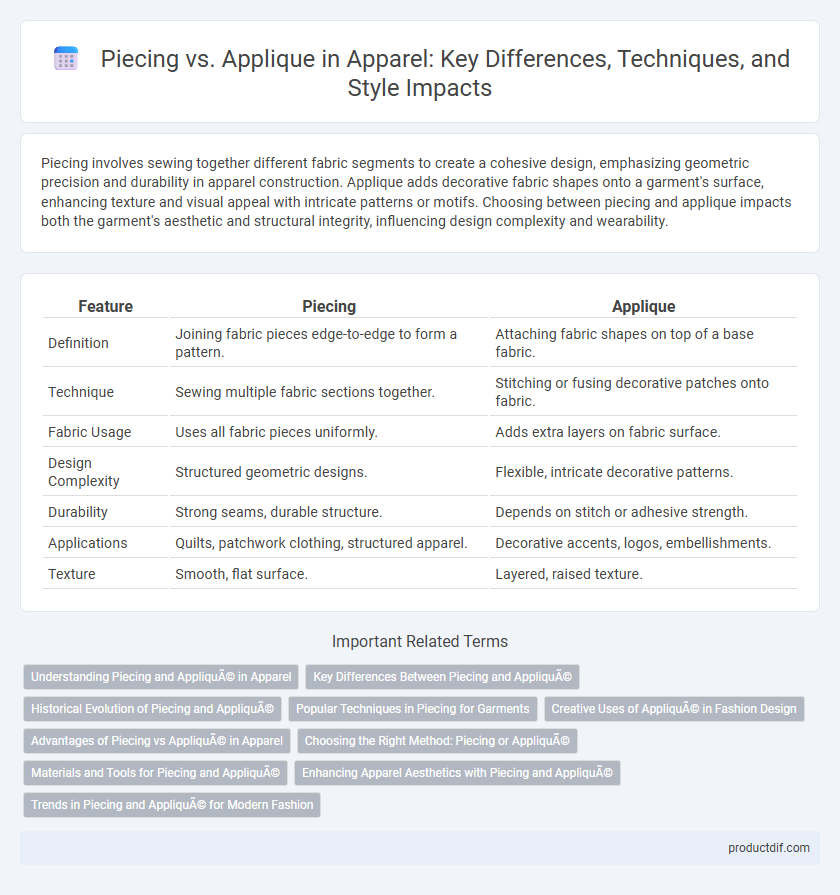Piecing involves sewing together different fabric segments to create a cohesive design, emphasizing geometric precision and durability in apparel construction. Applique adds decorative fabric shapes onto a garment's surface, enhancing texture and visual appeal with intricate patterns or motifs. Choosing between piecing and applique impacts both the garment's aesthetic and structural integrity, influencing design complexity and wearability.
Table of Comparison
| Feature | Piecing | Applique |
|---|---|---|
| Definition | Joining fabric pieces edge-to-edge to form a pattern. | Attaching fabric shapes on top of a base fabric. |
| Technique | Sewing multiple fabric sections together. | Stitching or fusing decorative patches onto fabric. |
| Fabric Usage | Uses all fabric pieces uniformly. | Adds extra layers on fabric surface. |
| Design Complexity | Structured geometric designs. | Flexible, intricate decorative patterns. |
| Durability | Strong seams, durable structure. | Depends on stitch or adhesive strength. |
| Applications | Quilts, patchwork clothing, structured apparel. | Decorative accents, logos, embellishments. |
| Texture | Smooth, flat surface. | Layered, raised texture. |
Understanding Piecing and Appliqué in Apparel
Piecing in apparel involves sewing together smaller fabric segments to create a larger design, enhancing texture and durability in garments. Applique consists of attaching decorative fabric shapes onto a base fabric, adding intricate patterns and visual appeal to clothing. Both techniques enable unique customization and artistic expression in fashion design.
Key Differences Between Piecing and Appliqué
Piecing involves sewing together small fabric sections to create a larger pattern, while applique attaches fabric shapes onto a base fabric for decorative effects. Piecing primarily builds the overall structure and design of a garment or quilt, whereas applique adds detailed embellishments and texture. Understanding these key differences helps designers choose techniques that best suit the desired aesthetic and fabric functionality in apparel creation.
Historical Evolution of Piecing and Appliqué
Piecing and applique have distinct historical roots in apparel design, with piecing originating from early quilting traditions where fabric scraps were systematically sewn together to create durable textile patterns. Applique evolved as a decorative technique in various cultures, involving the layering of fabric shapes onto a base garment to add intricate visual elements. Both methods have influenced modern fashion through their craftsmanship and aesthetic contributions, reflecting cultural heritage and artisanal innovation.
Popular Techniques in Piecing for Garments
Piecing techniques in apparel involve sewing together small fabric pieces to create intricate patterns or designs, with patchwork and strip piecing being highly popular for garment construction. Patchwork combines diverse fabric shapes into a unified textile, often used in quilts and bohemian-style clothing, while strip piecing entails sewing long fabric strips for geometric designs, enhancing both texture and visual appeal. These methods offer versatility and customization, making them favored in crafting unique, stylish clothing with detailed fabric compositions.
Creative Uses of Appliqué in Fashion Design
Applique in fashion design offers a versatile technique for adding texture, dimension, and intricate patterns to garments, enhancing visual interest beyond piecing methods. Designers creatively use applique to incorporate bold motifs, cultural symbols, and mixed materials like lace, leather, and sequins, resulting in unique, eye-catching apparel. This method allows for customization and storytelling in fashion, making it a preferred choice for high-end and avant-garde collections.
Advantages of Piecing vs Appliqué in Apparel
Piecing offers enhanced durability and seamless integration in apparel by stitching fabric pieces edge-to-edge, reducing bulk compared to applique, which layers fabric and can add weight. This technique allows for greater precision in garment construction and pattern alignment, resulting in a cleaner and more structured finish. Piecing also enables more efficient fabric utilization, minimizing waste and optimizing production costs in apparel design.
Choosing the Right Method: Piecing or Appliqué
Choosing between piecing and applique in apparel design depends on the desired texture, complexity, and durability of the garment. Piecing involves sewing together fabric sections to create patterns, offering structural integrity and a smooth finish ideal for quilts and patchwork clothing. Applique adds decorative elements by stitching fabric shapes onto a base fabric, providing intricate designs and visual depth suitable for embellishments on casual and formal wear.
Materials and Tools for Piecing and Appliqué
Piecing in apparel construction typically involves fabric squares or strips sewn together using sewing machines and rotary cutters, with materials such as cotton, denim, or quilting fabrics favored for their durability and ease of handling. Applique relies on layering fabric shapes onto a base fabric, utilizing tools like fusible web, embroidery hoops, and precise scissors or craft knives, with materials including felt, satin, or lace to create decorative effects. Both techniques require needles and threads, but applique often demands specialty threads and adhesives to secure intricate designs, while piecing focuses on strength and seam precision.
Enhancing Apparel Aesthetics with Piecing and Appliqué
Piecing and applique are key techniques in apparel design that enhance garment aesthetics through texture and visual interest. Piecing involves sewing together fabric sections to create patterns or color contrasts, while applique adds decorative fabric shapes to a garment's surface for intricate detailing. Both methods enrich the design, allowing for customization and unique stylistic expression in fashion collections.
Trends in Piecing and Appliqué for Modern Fashion
Piecing and applique techniques have evolved significantly in modern fashion, with designers embracing intricate patchwork and layered fabric motifs to create unique, textured garments. Trend-driven piecing showcases bold color blocking and geometric patterns, enhancing visual appeal and structural design in apparel collections. Applique trends highlight three-dimensional floral and abstract shapes that add depth and artisanal craftsmanship to contemporary clothing, reflecting consumer demand for personalized and artistic fashion pieces.
Piecing vs Appliqué Infographic

 productdif.com
productdif.com